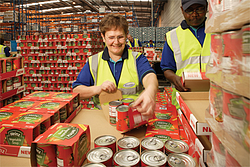 I will park the question of the value (or waste) of these activities for another day but where is the best place to carry out such operations? When you consider that some blue-chip FMCG producers co-pack/re-pack a majority of the volume coming out of their factory gates you realise this is not a small issue. How many products carry the original bar code into consumer’s houses? Not many!
I will park the question of the value (or waste) of these activities for another day but where is the best place to carry out such operations? When you consider that some blue-chip FMCG producers co-pack/re-pack a majority of the volume coming out of their factory gates you realise this is not a small issue. How many products carry the original bar code into consumer’s houses? Not many!
The best location for these operations?
1. At the producing factory? From an operating company (OPCO) perspective this provides the least complexity downstream in the chain. For factories seeking higher and higher efficiency and asset utilisation this can be nightmare for cost and complexity. Even if the factory is part of the same company many will refuse to entertain “abnormal” requests from sister operating companies.If an SKU requires a label that can be applied online without affecting speed then you might be ok. However, anything like banding together 2 different SKUs is unlikely to get a positive response. In any event, the 2 promotion-bound SKUs may be produced in different factories, countries and even continents.
2. At the OPCO warehouse? The stock is certainly closer to the final market destination so this makes sense but there are drawbacks to what providers call “added value services”. Seldom is a third party logistics provider (3PLP) set up to operate what is essentially a mini factory. If promotional volumes are low then you can deal with them on an ad hoc basis but where levels are higher you need a factory mentality and facilities and this is not common in 3PLPs.
Stock control is vital and a good quality WMS with added value functionality is a must. Knowing what product is where requires meticulous attention to master data detail. What goes into a re-packing location will come out with a completely different bar code – chaos prevails otherwise.
You are essentially locked into your 3PLP and he may well take advantage of that when it comes to pricing the work. Get this wrong and you will suffer unexpected and rising costs, stock “shrinkage” and a resultant drop in Customer Service Level.
3. At a specialist 3rd party? They do exist and if they are set up well and sensibly staffed this can work. You can expect a professional service and a well managed operation. Quality and flexibility will be higher and costs can be keen as the assets are not dedicated to a single company. Such a 3rd party is likely to have a wider portfolio of promotional options available and will invest in plant against a sound business case.
Of course, the downsides frighten potential clients away. You have the added cost and hassle of moving stock in and out of your logistical 3PLP and the associated longer lead times.
4. At the point of purchase (POP)? No, not as crazy as this might sound. If you can manage to get the same unadulterated SKU from the factory gate to the shelf then you are very lucky and secondly, you probably operate a slick chain.
Obviously, you will not be able to carry out the full menu of promotion assembly and display but this route does provide a tactical advantage that can catch competitors napping. An unannounced special price sticker or “buy 1 get 1 free” (BOGOF) promotion can pay dividends. You need the cooperation of the retailer but when there is mutual benefit, why not?
A blend of all 4 sounds like quite a unique opportunity. What do you think?
Image credit: Wincanton







